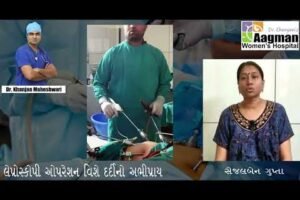Hysteroscopy
What is hysteroscopy?
Hysteroscopy is a minimally invasive procedure that allows doctors to examine and treat conditions inside the uterus. A thin, lighted tube called a hysteroscope is inserted through the vagina and cervix to provide a clear view of the uterine cavity. This procedure is commonly used for both diagnostic and therapeutic purposes and is an essential tool in modern gynecology for evaluating and managing various uterine conditions.

Why is hysteroscopy performed?
Hysteroscopy is recommended for various gynecological conditions, including:
- Infertility: To evaluate the uterine cavity for abnormalities that may affect conception and implantation.
- Endometrial polyp & Submucosal myoma: To remove benign growths that can cause heavy menstrual bleeding, pelvic pain, and fertility issues.
- Retained Products of Conception (RPOC): To remove remaining tissue after a miscarriage, incomplete abortion, or postpartum complications, reducing the risk of infection and future complications.

- Diagnosis of mullerian anomalies (Uterine septum): To detect and correct congenital abnormalities of the uterus that may lead to recurrent miscarriages or pregnancy complications.
- Asherman’s syndrome: To diagnose and treat intrauterine adhesions (scar tissue) that can cause menstrual irregularities, pain, or infertility.
- Unexplained abnormal uterine bleeding: To determine the cause of heavy, irregular, or postmenopausal bleeding and guide appropriate treatment.

Types of hysteroscopy
- Diagnostic hysteroscopy:Used to examine the uterus and identify any abnormalities. It is often performed in conjunction with other infertility investigations, such as hysterosalpingography (HSG) or ultrasound.
- Operative hysteroscopy: Involves the removal of polyps, fibroids, adhesions, or uterine septa using specialized instruments inserted through the hysteroscope. This eliminates the need for open surgery and provides a quicker recovery.
- Minimally invasive: No external incisions, reducing post-operative pain and scarring.
- Accurate diagnosis: Direct visualization of the uterine cavity allows precise identification of abnormalities.
- Effective treatment: Many conditions can be treated immediately during the same procedure.
- Quick recovery: Most patients return to normal activities within a day or two.
- Lower risk of complications: Compared to traditional surgical methods, hysteroscopy has fewer risks and a shorter hospital stay.
Hysteroscopy Procedure
Preparation may vary depending on whether the procedure is diagnostic or operative. Your doctor may recommend:
- Scheduling the procedure: Ideally performed in the first half of the menstrual cycle (after periods end but before ovulation) for better visualization.
- Fasting: If undergoing hysteroscopy under general anesthesia, fasting for a few hours before the procedure is required.
- Medications: You may be given pain relievers or antibiotics before the procedure.
- Avoiding intercourse: Refraining from sexual activity for a few days before the procedure may be recommended.
Hysteroscopy is usually performed on an outpatient basis. The steps include:
- Anesthesia: Depending on the complexity of the procedure, local, regional, or general anesthesia may be administered to ensure patient comfort.
- Insertion of the hysteroscope: A speculum is gently inserted into the vagina to hold it open. The hysteroscope, a thin tube with a light and camera, is then carefully guided through the cervix into the uterus.
- Uterine distension: To create a clear view of the uterine cavity, a sterile fluid (saline or glycine solution) or carbon dioxide gas is introduced, gently expanding the uterus.
- Examination & Treatment: The doctor carefully examines the uterine walls, identifying any polyps, fibroids, adhesions, or other abnormalities. If necessary, specialized instruments are passed through the hysteroscope to perform procedures such as:
- Removing polyps or fibroids.
- Cutting or reshaping uterine septa.
- Removing scar tissue from Asherman’s syndrome.
- Taking a biopsy if further examination is needed.
- Completion: Once the procedure is complete, the instruments and fluid are removed. The patient is monitored for a short period before being discharged with aftercare instructions.
Most patients recover quickly and can resume normal activities within a day or two. Some common post-procedure experiences include:
- Mild cramping: Similar to menstrual cramps, which subside within a few hours to a day.
- Light spotting: Mild bleeding for a few days is normal.
- Temporary bloating or discomfort: Due to the use of saline or gas to expand the uterus.
- Medications: Pain relievers or antibiotics may be prescribed to prevent infection and manage discomfort.
- Follow-up appointment: A check-up may be scheduled to review results and discuss further treatment if needed.
What are the risks of a hysteroscopy?
While hysteroscopy is generally safe, potential risks include:
- Infection: Rare but possible; symptoms include fever and unusual discharge.
- Uterine perforation: A rare complication where the instrument creates a small hole in the uterus, sometimes requiring further treatment.
- Excessive bleeding: Uncommon but may occur in some cases.
- Adverse reaction to anesthesia: If general anesthesia is used.
Why choose Aagman for hysteroscopy in Palanpur?
At Aagman Women’s Hospital, we specialize in advanced hysteroscopic procedures with a commitment to precision, safety, and patient comfort. Here’s why patients trust us for hysteroscopy:

Experienced gynecologists
Our expert gynecologists, Dr. Khanjan Maheshwari & Dr. Krupa Maheshwari, have successfully performed thousands of hysteroscopy procedures with high success rates.

State-of-the-art facilities
We use advanced medical technology, ensuring precise diagnosis and effective treatment.

Personalized care for every patient
We create customized treatment plans to suit individual health needs.

Minimally invasive & quick recovery
X% of our patients resume normal activities within 24-48 hours.

Comprehensive women’s health services
We provide complete gynecological and fertility care under one roof, benefiting over 5,000 patients annually.

High patient satisfaction
Our commitment to compassionate care and positive patient experiences has earned us a X% satisfaction rate among our patients.
At Aagman Women’s Hospital, we prioritize your reproductive health with cutting-edge techniques and compassionate care. If you’re facing uterine health concerns, trust our expert team to provide safe and effective hysteroscopic treatment.
📍 Located in Palanpur, Gujarat, we take pride in providing top-quality hysteroscopic care to women seeking effective, minimally invasive treatment.
💖 Your well-being matters—Schedule a consultation today and take the first step toward a healthier future.
Read real stories from patients who trusted Aagman Women’s Hospital
Divyam Raval
Preeti Thakor
Swati Rajpurohit
Dinesh Goswami
Mohit Ramvani
Shree Shyam Construction
FAQs
Most patients can resume light activities within 24 hours. However, we recommend avoiding strenuous activities and heavy lifting for at least a week to ensure proper healing.
Yes, we specialize in using hysteroscopy for diagnosing and treating fertility-related issues, such as uterine polyps, adhesions, and congenital anomalies that may impact conception.
No, hysteroscopy is an outpatient procedure at our hospital. Patients can return home the same day, typically within a few hours of the procedure.
We offer local anesthesia for diagnostic procedures and general anesthesia for operative hysteroscopies. Our team ensures your comfort with appropriate pain relief options before and after the procedure.
You can schedule an appointment by calling our reception desk, visiting our hospital in Palanpur, or booking online through our website. Our team will guide you through the preparation and procedure details.
Our team provides personalized post-operative care, including pain management, follow-up consultations, and guidance for a smooth recovery. If you experience any concerns, our specialists are available to assist you.
A diagnostic hysteroscopy typically takes 10-30 minutes, while an operative hysteroscopy may take up to an hour, depending on the complexity of the treatment.
Depending on the procedure, we offer local, regional, or general anesthesia to ensure patient comfort. Our doctors will discuss the best option based on your specific needs.
This depends on the condition treated. In most cases, women can try to conceive after their next menstrual cycle. Our doctors provide personalized guidance based on your health condition.
Our doctors will provide detailed instructions, which may include scheduling the procedure after your period, fasting if anesthesia is required, and avoiding intercourse or certain medications before the procedure.
Yes, we specialize in both diagnostic and operative hysteroscopy, ensuring precise diagnosis and treatment under one roof.
We offer state-of-the-art technology, experienced gynecologists, and a patient-centered approach, ensuring safe and effective treatment.
We assist patients with insurance-related queries and can help determine coverage options for hysteroscopy.
Yes, we use cutting-edge hysteroscopic equipment for high precision and minimal discomfort during the procedure.
Absolutely! Our gynecologists provide thorough consultations, discuss alternatives, and address all your concerns before proceeding.










